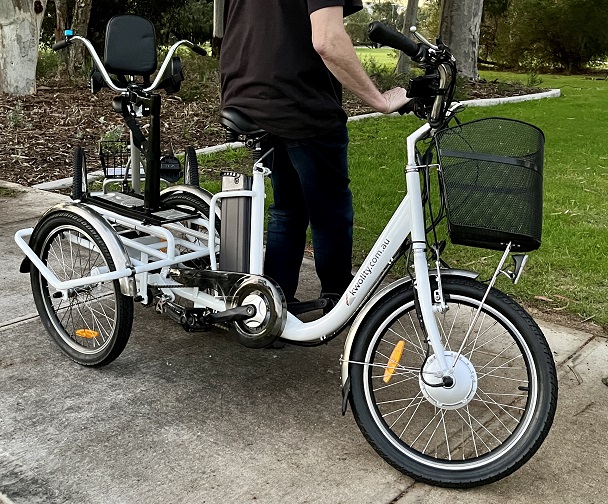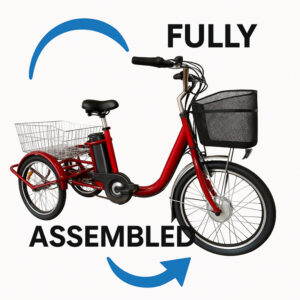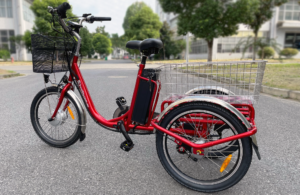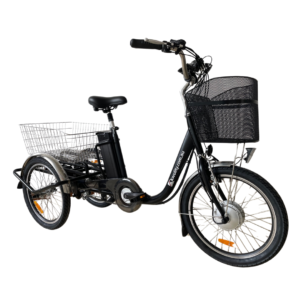
Tilting Cargo E-Trikes Are Growing — Kowlity Has Been Doing It Since Day One
Tilting cargo e-trikes are becoming one of the most exciting parts of the riding world. Riders love the smooth lean-into-corners feel combined with the stability

Kwolity E-Trikes have become a well-known, reliable feature of the trike landscape in Australia. It’s unique tilting function sets it apart from fixed e-trikes as it eliminates many of the cornering issues that trikes or 3-wheel vehicles encounter. In addition, it allows the trike to be smaller in dimensions and can fit through standard doorways, a boon for unit or flat dwellers. Its low centre of gravity, its 20-inch wheels and the carrying capacity has been very well received in the Australian marketplace.
The heart and soul of the trike is of course, its battery and the assistance it gives to the rider. For Seniors, the assistance of the electric motor, is both liberating and exhilarating. When combined with the comparative safety of the tilting function, older citizens are finding new leases on life by being able to get out and about.
Voltage and Capacity: The Kwolity E-Trike battery is 36 volts, 10 amp/h and comes as standard. To increase the distance that can be travelled, there is an option to increase the amp/h range to 15 or 19.2 amp/h.
Range: The standard range for the Kwolity E-Trike is 45 to 50 kilometres, depending upon the weight of the rider (and goods, dogs etc) being carried. Terrain is also as major factor. Hilly regions consume more of the battery power as the trike is under greater pressure climbing. The bigger batteries are more commonly used in these situations, as the Watts are increased (Volts X amp/h = Watts). So, a standard battery has 360W available, 15amp/h is 540W and 19.2amp/h is 702W.
Build Standards: International and factory standards that apply in the manufacturing process, both batteries and charger. With the charger, it’s a smart or intelligent charger, employing power switching designed specifically for Lithium-Ion batteries. It fully complies with the European Union RoHS standards. Users are encouraged to follow the Instruction booklet guidelines for safe, optimum usage.
The Battery: Here’s a breakdown of what you’d typically find inside an e-bike battery:
Battery Cells
Individual Cylindrical Cells: These look like standard AA batteries. They are arranged in rows and columns, connected in series and parallel.
Prismatic or Pouch Cells: Flat, rectangular cells that can be packed together more densely within the battery casing.
Battery Management System (BMS)
Circuit Board: A small circuit board that monitors the health of the battery cells.
Functions: Protects against overcharging and over-discharging
Balances the voltage across the individual cells
Regulates temperature to avoid overheating
Provides information on battery capacity and status
Wiring and Connectors
Wires: Connect the cells to each other and to the BMS.
Connectors: Allow the battery to be attached and removed from the e-bike.
Casing: Typically plastic or metal: Protects the internal components from impacts and the elements.
Sealing: Designed to keep out dust and moisture.
Important Note: Do not attempt to open an e-bike battery yourself. Lithium-ion batteries contain high voltage and can be hazardous if mishandled. Repairs should always be left to qualified professionals.
Best Charging Practices
The battery can be charged either in-situ on the trike or, having lifted the seat, it can be unlocked, lifted out and charged away from the trike.
Lithium-ion batteries do not have a memory like lead-acid batteries commonly found in automobiles. They can be run quite low (do not flatten) or topped up regularly as the rider might choose.
Avoid overcharging. The charger will show a red light whilst charging and turn to green when fully charged. When fully charged, turn off the 240V power and disconnect the charger from the trike. It is not good practice to leave it on overnight even if it’s a smart charger. A Lithium-ion battery consists of lithium-ion cells. These cells contain a flammable electrolyte fluid that can ignite and cause a chain reaction of thermal runaway, resulting in an explosion. Its not limited by the trike or bike, it can happen wherever one has a lithium-ion battery, from your watch, vacuum cleaner, phones, electric cars or laptops etc. It’s an extremely rare occurrence but it gets plenty of headlines when it occurs.
Store batteries when not in use in a cool, dry place. Also recharge every 3 months or so to keep the battery in good condition.
E-Trike fires are rare and avoidable, if you take good care of your battery and use it responsibly.
Battery Care Tips
Temperature considerations (avoid extreme heat/cold)
Proper storage practices for extended non-use
Cleaning and maintenance. Check the battery from time to time. Look for any signs of damage, swelling or leakage. Under no circumstances, tamper with the workings of the battery. It will not only void the warranty, it is also dangerous.
When to consider upgrading: Increased range is the most likely reason to upgrade from the standard battery. Terrain can also be a contributing factor. The life of a battery is around 800 to 1,000 cycles (the number of times it can be charged before deteriorating).
Where to buy batteries and chargers: Contact Kwolity or its dealership.
E-trike and or e-bike fires are rare and avoidable if you take care of the battery and use it responsibly.
E-Trikes and e-bikes are a great way to enjoy the benefits of cycling, such as saving time and money, improving your health and fitness, reducing your environmental impact and most importantly, having fun and convenience.

Tilting cargo e-trikes are becoming one of the most exciting parts of the riding world. Riders love the smooth lean-into-corners feel combined with the stability

Buying a trike should be exciting, not stressful. That’s why at Kwolity, we make it simple, every trike we sell is delivered fully assembled and

Electric trikes, or e-trikes, are becoming increasingly popular for their convenience, efficiency, and environmentally friendly nature. One of the standout features of e-trikes is their

Choosing the right e-trike system can be a game-changer for the overall riding experience. At Kwolity E Trikes, we’ve opted for the 36V system over